
Trauma
Corrèze, France, 2008–09
series of 48 photographs,
38 x 57.7 cm; 57.7 x 38 cm, gelatine silver prints; chromogenic prints
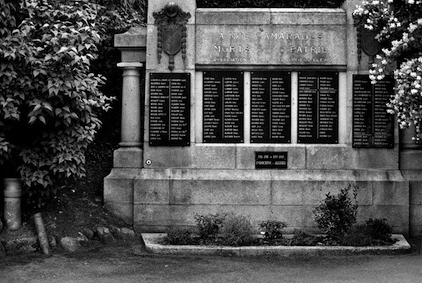 |
Ahlam Shibli, untitled (Trauma no. 1), Corrèze, France, 2008–09, gelatine silver print, 38 x 57.7 cm. Tulle, 18th May, 2008. Monument at the entrance of the Lycée Edmond Perrier in Tulle honouring its former students and one professor morts pour la France in the First and Second World Wars, and the colonial wars in Indochina and Algeria. Courtesy of the artist, © Ahlam Shibli |
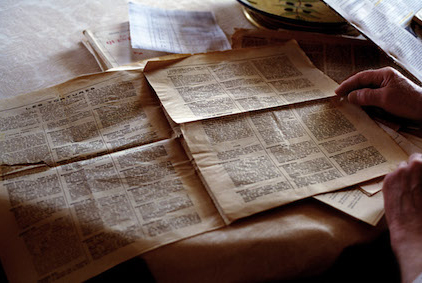 |
Ahlam Shibli, untitled (Trauma no. 2), Corrèze, France, 2008–09, chromogenic print, 38 x 57.7 cm. Chanac-les-Mines, 18th June, 2008. Documentation of torture by the French Army in Algeria shown by Daniel Espinat. He explained that during the Algerian War he used to receive such documents secretly from the PSU (Parti socialiste unifié) and distribute them in the Corrèze region. During the German occupation of France, Daniel Espinat was a member of the Armée secrète – Corps franc de libération de Tulle. Later he became an activist against the Algerian War. The Armée secrète was an organisation of Résistance fighters created in 1942. Courtesy of the artist, © Ahlam Shibli |
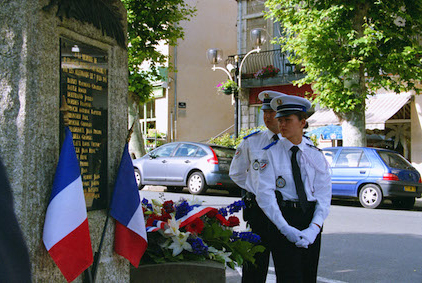 |
Ahlam Shibli, untitled (Trauma no. 3), Corrèze, France, 2008–09, chromogenic print, 38 x 57.7 cm. Tulle, 7th June, 2008. Wreath-laying ceremony at the stele of the Square du Souvenir Français to commemorate eighteen track-watchmen murdered by the Wehrmacht on the 7th June, 1944. While members of the Francs-tireurs et Partisans (FTP) were launching an attack on the German garrison at the Hôtel Dufayet in Tulle, twenty-one French citizens who had been obliged to guard the railway against sabotage, took refuge in the coal bunker at the train station. When they heard German soldiers entering the station, they came out with their hands raised for fear of being confused with the Maquis. A German soldier ordered them to march to the Hôtel Dufayet. Then Germans who were standing in front of the Hôtel Dufayet and the Hôtel Terminus fired on them, killing three. The rest were ordered to proceed to the railway sidings which they did with their hands raised. A number of different German soldiers let them pass without saying anything and suddenly opened fire on them. In total eighteen track-watchmen were killed. Only one man, Abel Leblanc, who was covered with the blood of another man and pretended to be dead, survived and reported the events. His report doesn't say anything about the two watchmen not accounted for. The Square du Souvenir Français received its name in connection with a statue of Sergeant Lovy located close to the stele commemorating the train-watchmen. The statue of Sergeant Lovy was erected in honour of that member of the French colonial army who was born in Tulle in 1880 and died in Algeria, on the 29th March, 1903, in a clash with Kabyl rebels. Courtesy of the artist, © Ahlam Shibli |
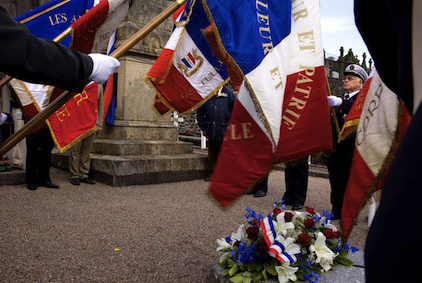 |
Ahlam Shibli, untitled (Trauma no. 4), Corrèze, France, 2008–09, chromogenic print, 38 x 57.7 cm. Tulle, 7th June, 2009. Wreath-laying ceremony at the Nécropole des FFI in the cemetery of Puy Saint-Clair, carré militaire, to commemorate the fighters of the Forces françaises de l'intérieur (FFI), including members of the Francstireurs et Partisans (FTP), who fell during the Résistance attack in Tulle on the 7th and 8th June, 1944. Under the slab of granite twenty-two soldiers of the FFI are buried, thirteen of whom are unknown. Courtesy of the artist, © Ahlam Shibli |
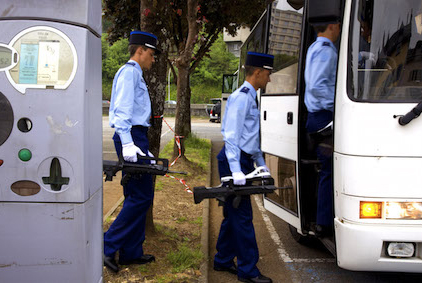 |
Ahlam Shibli, untitled (Trauma no. 5), Corrèze, France, 2008–09, chromogenic print, 38 x 57.7 cm. Tulle, 8th May, 2009. 8th May celebration of Germany's unconditional surrender. On the day of Germany's surrender, the 8th May, 1945, in Sétif and Guelma, in Algeria, large numbers of Algerian civilians decided to express their right to independence. Their demonstrations were violently repressed by the French police, the army and the colonists' militias. That day and the following days, thousands of Algerian civilians were killed in the massacres at Sétif and Guelma. Courtesy of the artist, © Ahlam Shibli |
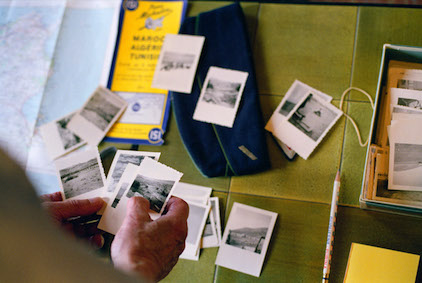 |
Ahlam Shibli, untitled (Trauma no. 6), Corrèze, France, 2008–09, chromogenic print, 38 x 57.7 cm. Tulle, 14th June, 2008. René Lavigne, called for 'prolonged military service', as he phrased it, looking at photos he made in Algeria, showing actions of his detachment in the Algerian War. Starting February 1955, René Lavigne served in Germany for one year. Then he was sent to Tunisia for six months, and after that to Algeria, where he stayed for the rest of his military service, until July 1957. René Lavigne is married to Andrée, a daughter of Sylvain Combes who was a member of the Armée secrète and was arrested on the 14th May, 1943, for acts of resistance in Tulle, then deported to Buchenwald and from there to Nordhausen-Dora, a camp which provided forced labour for the Mittelwerk V–1 and V–2 rocket factory in the Kohnstein mountain. Sylvain Combes died at the Dora camp on the 15th December, 1943. Courtesy of the artist, © Ahlam Shibli |
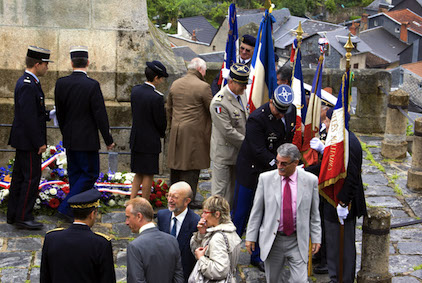 |
Ahlam Shibli, untitled (Trauma no. 7), Corrèze, France, 2008–09, chromogenic print, 38 x 57.7 cm. Tulle, 8th June, 2009. Wreath-laying ceremony at a national day of commemoration, declared by the French government in 2005, to honour those morts pour la France in Indochina, at the monument aux morts in rue Sylvain Combes. The monument was erected by the town of Tulle in 1923 to honour the victims of the First World War. After the liberation a plaque was added in memory of the 'children' of Tulle morts pour la France in the Second World War, 'soldiers fallen on the field of honour, prisoners, the hanged, the deported, all the heroes of the Résistance, victims of Hitler's barbarism'. The monument also carries plaques referring to those morts pour la France in the Far East, i.e. Indochina, and to those who fell in 1954–1962 in Algeria, Tunisia, and Morocco. The plaque commemorating the fallen participants of the fighting in North Africa was attached to the monument by the Amicale tulliste des anciens mobilisés en Afrique (ATAMA), with the permission of the municipality of Tulle. It was inaugurated on the 19th March, 1967, in the presence of the deputy mayor of Tulle, Jean Montalat, member of the Section française de l'Internationale ouvrière (SFIO). Sylvain Combes, who was deported to a German concentration camp on the 15th May, 1943, lived with his wife and their two daughters in the quarters of the concierge of the Ecole normale d'instituteurs, a college for teachers training, not far from the monument aux morts. The street was baptised after him on the 13th February, 1946 Courtesy of the artist, © Ahlam Shibli |
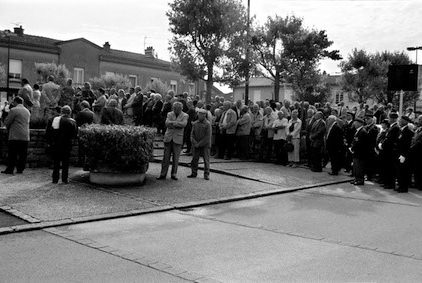 |
Ahlam Shibli, untitled (Trauma no. 8), Corrèze, France, 2008–09, gelatine silver print, 38 x 57.7 cm. Oradour–sur–Glane, 10th June, 2008. Wreath-laying ceremony in front of the city hall of Oradour–sur–Glane to commemorate the 10th June, 1944 murder by the Nazis of 642 men, women and children. On that day, a detachment of the 2nd armoured SS division 'Das Reich' which was responsible for the atrocities committed in Tulle the day before, shot to death and burnt the men of Oradour. The women and children were burnt alive in the church. The village was torched and completely incinerated. After the war a new village was built nearby. The original site of the village has been maintained as a memorial at the suggestion of General de Gaulle. Courtesy of the artist, © Ahlam Shibli |
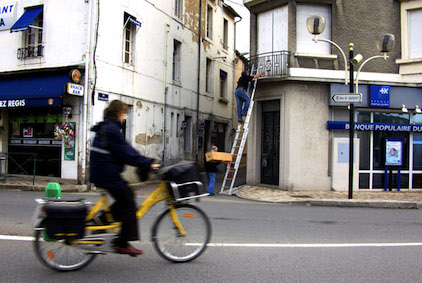 |
Ahlam Shibli, untitled (Trauma no. 9), Corrèze, France, 2008–09, chromogenic print, 38 x 57.7 cm. Tulle, 9th June, 2009. Placing bouquets of flowers on the morning of the 9th June celebrations at the places where 99 men from Tulle were hanged by the 2nd armoured SS division 'Das Reich' on the 9th June, 1944. Courtesy of the artist, © Ahlam Shibli |
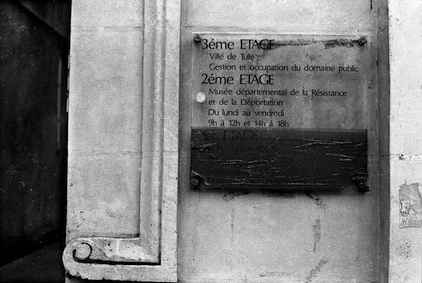 |
Ahlam Shibli, untitled (Trauma no. 10), Corrèze, France, 2008–09, gelatine silver print, 38 x 57.7 cm. Tulle, 13th June, 2008. Entrance to the Musée départemental de la Résistance et de la Déportation at 2, quai Edmond Perrier, in Tulle. Courtesy of the artist, © Ahlam Shibli |
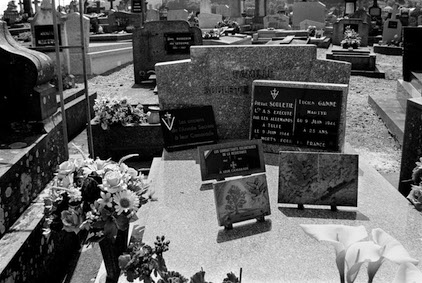 |
Ahlam Shibli, untitled (Trauma no. 11), Corrèze, France, 2008–09, gelatine silver print, 38 x 57.7 cm. Tulle, 19th June, 2008. Cemetery of Puy Saint–Clair in Tulle where some of the 99 residents of Tulle hanged by the Nazis on the 9th June, 1944 and some of the men who had been deported to German concentration camps the next day are buried in family vaults. Courtesy of the artist, © Ahlam Shibli |
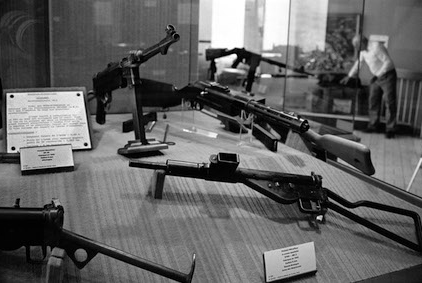 |
Ahlam Shibli, untitled (Trauma no. 12), Corrèze, France, 2008–09, gelatine silver print, 38 x 57.7 cm. Tulle, 19th June, 2008. In the same vitrine at the Musée des armes in Tulle several submachine guns are displayed: a Bergmann MP 18.1, fabricated in 1918 in Suhl, Germany, and used on the last days of the First World War at the Western Front; a MP-40, widely used by the Germans during the Second World War; a British STEN-MK2 and a STEN-MK5, weapons used by the Maquis; another STEN produced illegally during the Occupation for the Résistance at a motor factory in Limoges belonging to the Gnome & Rhône group; different models of the MAT-49, produced in the years 1949–62 at the Manufacture d'armes de Tulle (MAT), and used by the French Army in the First Indochina War, the Algerian War, and the 1956 Suez Crisis. Courtesy of the artist, © Ahlam Shibli |
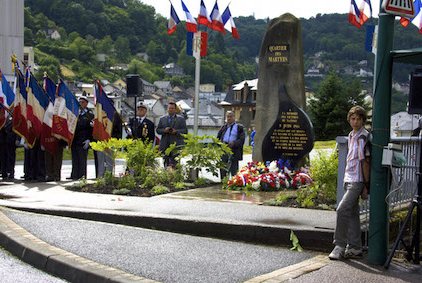 |
Ahlam Shibli, untitled (Trauma no. 13), Corrèze, France, 2008–09, chromogenic print, 38 x 57.7 cm. Tulle, 9th June, 2009. Wreath-laying ceremony at the Stèle des Martyrs, rue Louisa Paulin, in Tulle, to commemorate the 99 men from Tulle hanged from balconies and lamp posts by the 2nd armoured SS division 'Das Reich' on the 9th June, 1944 and the 149 residents who were deported on the 10th June, 1944 to German concentration camps, from where 101 of them did not return. Participating in this ceremony to honour the civilian victims of the Nazi atrocities are veterans of the Second World War and the colonial wars in Indochina and North Africa with the flags of their associations. Courtesy of the artist, © Ahlam Shibli |
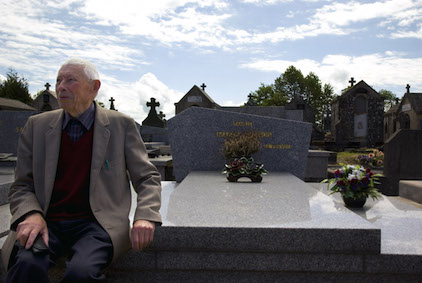 |
Ahlam Shibli, untitled (Trauma no. 14), Corrèze, France, 2008–09, chromogenic print, 38 x 57.7 cm. Clergoux, 18th May, 2009. Jean Maison, a former member of the Francs tireurs et Partisans (FTP) and member of the PCF (Parti communiste français), sitting next to the grave he prepared for his wife and himself. The FTP were a fighting formation of the French Résistance created in 1941 by the Communist Party that was open to non-communists but under communist control. By 1944, the FTP had an estimated strength of 100,000 men. The FTP became one of the first Résistance groups in France to deliberately assassinate Nazis. In February 1944, it was integrated into the Forces françaises de l'intérieur (FFI). Courtesy of the artist, © Ahlam Shibli |
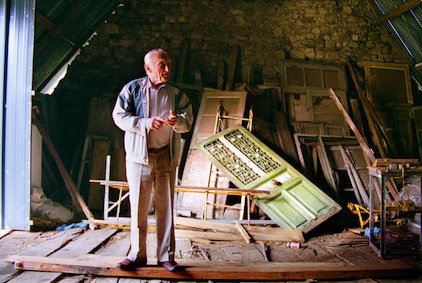 |
Ahlam Shibli, untitled (Trauma no. 15), Corrèze, France, 2008–09, chromogenic print, 38 x 57.7 cm. Le Monteil de Sarran, 25th June, 2008. Daniel Espinat at Le Monteil de Sarran in Corrèze in the barn where his group of Maquis trained and slept in July 1944. Maquis is a name for armed members of the Résistance who were hiding in the woods and mountainous areas. Of Corsican origin, the word means 'dense vegetation'. The first Résistance fighters were joined by masses of men who left their home to avoid the Service de travail obligatoire (STO) of the Vichy regime, which provided forced labour for the Germans. These men were gathered by the different groups of Maquis which became successively more organised to fight the Vichy regime and the German occupation. Courtesy of the artist, © Ahlam Shibli |
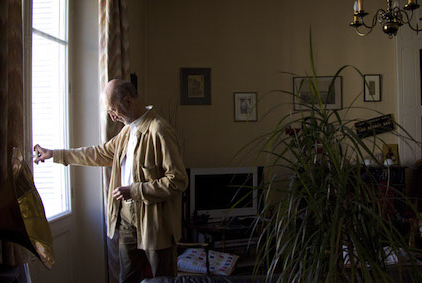 |
Ahlam Shibli, untitled (Trauma no. 16), Corrèze, France, 2008–09, chromogenic print, 38 x 57.7 cm. Tulle, 29th May, 2009. Pierre Diederichs showing how a German soldier entered his grandmother's apartment on the morning of the 9th June, 1944, while he was having breakfast, to tie a rope to the balcony for one of the hangings. In the end nobody was hanged from that rope. Initially it had been announced that 120 men would be hanged. Finally however the SS decided to reduce the number to 99. Pierre Diederichs' father, Noël Alfred Diederichs, was among the people rounded up by the Germans in the early morning of the 9th June, 1944. He was deported on the 10th June, 1944, via the detention camp Royallieu in Compiègne, to the German concentration camp Dachau, and later to the camps of Flossenbürg and Hersbruck, where he died on the 14th November, 1944. Courtesy of the artist, © Ahlam Shibli |
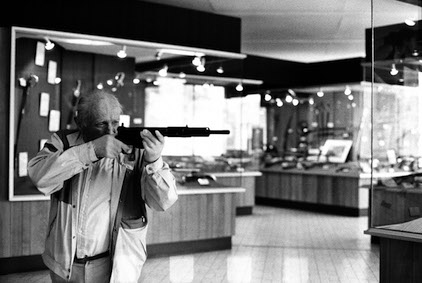 |
Ahlam Shibli, untitled (Trauma no. 17), Corrèze, France, 2008–09, gelatine silver print, 38 x 57.7 cm. Tulle, 25th June, 2008. Daniel Espinat at the Musée des armes in Tulle, demonstrating a STEN-MK5 gun, like the one he used during the Résistance. Courtesy of the artist, © Ahlam Shibli |
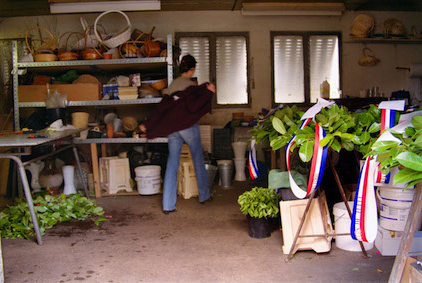 |
Ahlam Shibli, untitled (Trauma no. 18), Corrèze, France, 2008–09, chromogenic print, 38 x 57.7 cm. Tulle, 7th June, 2008. The Montagnac flower workshop in Tulle that each year prepares and positions the bouquets for the 7th , 8th, and 9th June celebrations. Courtesy of the artist, © Ahlam Shibli |
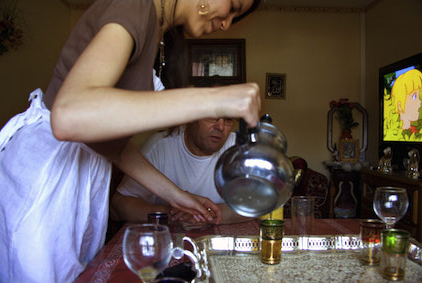 |
Ahlam Shibli, untitled (Trauma no. 19), Corrèze, France, 2008–09, chromogenic print, 38 x 57.7 cm. Tulle, 19th May, 2009. Nora Bellil pouring herself a cup of tea while her father, Abdenour Bellil, an Algerian immigrant, is looking on. Abdenour Bellil went to France in 1970 when he was twenty in search for a job. He first worked in Paris in a factory of mechanical parts for aviation and then as a waiter. Since 1978 he has been working in Corrèze in a parquet floor factory. The woman who later became his wife, Saliha, arrived in France in 1990 after finishing her studies in Algeria. They met in Poitiers, where each has family. Their three children were born in Tulle. Abdenour Bellil recounted that he saw the women of his family put animal excrement on their faces and bodies in order to protect themselves from being raped by French soldiers during the Algerian War. He also demonstrated how men from his village were handcuffed by the French Army. Courtesy of the artist, © Ahlam Shibli |
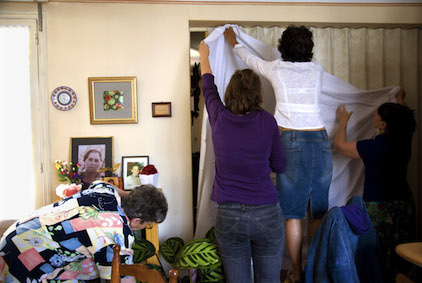 |
Ahlam Shibli, untitled (Trauma no. 20), Corrèze, France, 2008–09, chromogenic print, 38 x 57.7 cm. Tulle, 25th May, 2009. Concepción Le Guen, a Pied-Noir, and her daughter Claudine with Marie Trillo Pouget and Gaëlle Rhodes from the association Peuple et Culture Corrèze, preparing for a show of her slides from Algeria. Courtesy of the artist, © Ahlam Shibli |
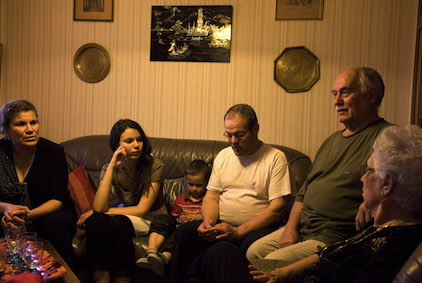 |
Ahlam Shibli, untitled (Trauma no. 21), Corrèze, France, 2008–09, chromogenic print, 38 x 57.7 cm. Tulle, 19th May, 2009. Saliha and Abdenour Bellil, their daughter Nora and their small son Anis, immigrants from Algeria, visiting Odette and Georges Claux, a Pied-Noir couple from Oran, in Algeria. Both families live in the Virevialle neighbourhood in Tulle. Courtesy of the artist, © Ahlam Shibli |
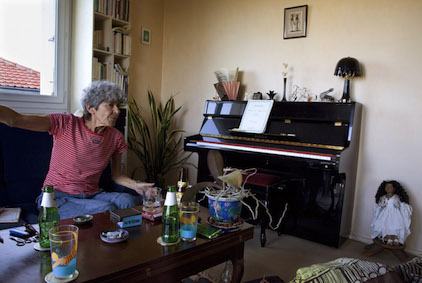 |
Ahlam Shibli, untitled (Trauma no. 22), Corrèze, France, 2008–09, chromogenic print, 38 x 57.7 cm. Tulle, 13th June, 2009. Saïda Amarouche in her living room in Tulle. Saïda Amarouche's father emigrated with his family in the 1930s from Algeria to France still a young man. Later he married an Algerian woman. Saïda was born in Marseille and considers herself at home at the place where she lives. She reported that during the Algerian War, when she was ten, her teacher asked her in relation to the war, 'Why are you doing that? Aren't you happy here?'. Courtesy of the artist, © Ahlam Shibli |
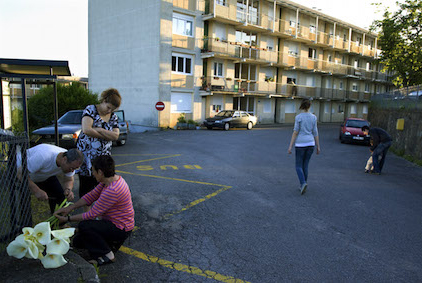 |
Ahlam Shibli, untitled (Trauma no. 23), Corrèze, France, 2008–09, chromogenic print, 38 x 57.7 cm. Tulle, 16th May, 2009. Manée Teyssandier, from the association Peuple et Culture Corrèze, with Abdenour Bellil, who is holding calla lilies that he cut for her at his allotment. At his side stands his wife Saliha. Their three children, Nora, Medhi, and their little son Anis, are playing in front of the building in the Virevialle neighbourhood, in Tulle, where the Bellil family lives on the second floor. Courtesy of the artist, © Ahlam Shibli |
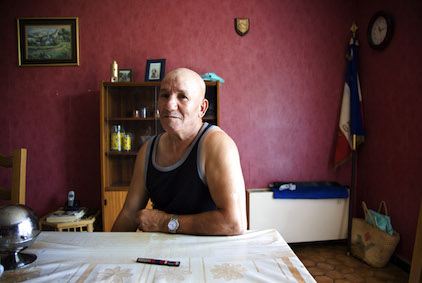 |
Ahlam Shibli, untitled (Trauma no. 24), Corrèze, France, 2008–09, chromogenic print, 38 x 57.7 cm. Cosnac, 12th June, 2009. Ameur Naceur, a Harki who came to France as a result of Algerian independence, presenting the medal ribbon he received as a member of the French Army during the Algerian War. He explained that the colour of the ribbon had to do with the number of Algerian fighters one had killed. In the corner of the living room he has placed the flag of the Harki association in Corrèze. Harki, from the Arabic word harka, is the term used for Algerians serving with the French Army during the Algerian War from 1954 to 1962. Courtesy of the artist, © Ahlam Shibli |
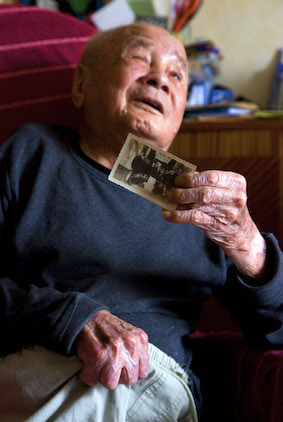 |
Ahlam Shibli, untitled (Trauma no. 25), Corrèze, France, 2008–09, chromogenic print, 38 x 57.7 cm. Tulle, 14th June, 2009. Thin Kieu showing a photo from 1946 depicting, according to the inscription on its back, the inauguration of a memorial honouring Ngi Muge Thai Hoc who died as a war hero for France which he considered his country. While showing that picture, Thin Kieu relates that on the 17th September, 1946, after the Fontainebleau Conference and before boarding a ship at Toulon to return to Vietnam, Ho Chi Minh visited the camp of Indochinese workers at Mazargues, near Marseille. Thin Kieu was among the 2,000 workers attending that meeting. He explained that his colleagues and himself supported the Vietnamese claim for independence because they felt mistreated by colonial France. Thin Kieu was one of 20,000 men France recruited by force in its colony in the Far East to replace French workers who had been called to arms. In 1939, when he was 24, he was taken by the French colonial administration from his village in Indochina to a gathering camp where he stayed for several months, and then to France to work in a weapons factory in Saint-Médarden-Jalle. During the German occupation Thin Kieu was relocated to Marseille. After the war he refused to be sent back to Indochina, fearing he would be considered a collaborator of the colonial power. In Marseille he met a French woman who had returned from a German concentration camp, and went with her to her hometown, Tulle, where he settled and married another local woman, Marguerite Peythieu. His papers reveal that only on the 12th April, 1949 was he 'temporarily relieved of his obligations', and on the 31st December, 1952 definitely 'relieved of his commitment'. Courtesy of the artist, © Ahlam Shibli |
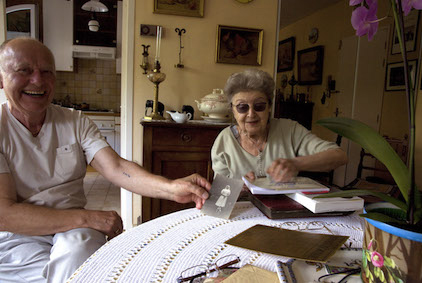 |
Ahlam Shibli, untitled (Trauma no. 26), Corrèze, France, 2008–09, chromogenic print, 38 x 57.7 cm. Tulle, 2nd June, 2009. Michel Trésallet presenting a photo of the lady next to him, Pierrette Barrat-Arnal, which shows her as a nurse at the Manufacture d'armes de Tulle (MAT), during the Occupation. While working at MAT, Pierrette Barrat-Arnal provided medical supplies and food stamps for the Résistance. Michel Trésallet's father, Louis Trésallet, was deported on the 10th June, 1944, sent to Dachau via the detention camp Royallieu in Compiègne and from there transferred to the Flossenbürg and Hersbruck camps, where he died on the 25th November, 1944. At a time of personal hardship, Michel Trésallet had his father's concentration camp number tattooed to his own arm to remind him of the value of life. Courtesy of the artist, © Ahlam Shibli |
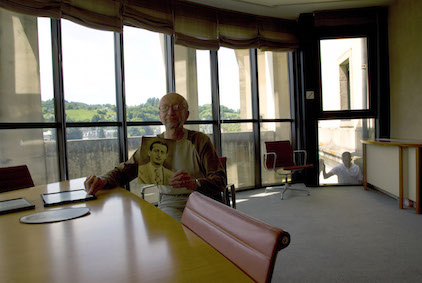 |
Ahlam Shibli, untitled (Trauma no. 27), Corrèze, France, 2008–09, chromogenic print, 38 x 57.7 cm. Tulle, 20th May, 2009. Pierre Diederichs presenting a photo of his father, Noël Alfred Diederichs, who died at the Hersbruck concentration camp on the 14th November, 1944. Courtesy of the artist, © Ahlam Shibli |
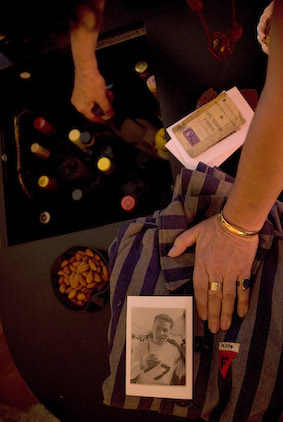 |
Ahlam Shibli, untitled (Trauma no. 28), Corrèze, France, 2008–09, chromogenic print, 38 x 57.7 cm. Tulle, 28th May, 2009. Françoise Bonneau offering an apéritif. On the table are displayed the clothes her father, René Bonneau, was wearing when he returned home from Dachau in 1945, and a photo from his time as an Alpine Hunter before deportation. René Bonneau was one of the 149 men of Tulle who were deported on the 10th June, 1944. After returning from the Dachau concentration camp, he resumed service with the French occupation forces in Austria. Later he fought in the First Indochina War. Asked to take part in the Algerian War, he decided not to leave his family again, resigned from the army and started to work as a guard at the Manufacture d'armes de Tulle (MAT). Before Françoise Bonneau's mother, Andrée Fougère, married René Bonneau, she was married to Michel Marcel Lamarre, one of the 99 men who were hanged on the 9th June, 1944. She is buried between her two husbands at the cemetery of Puy Saint-Clair, in Tulle. Courtesy of the artist, © Ahlam Shibli |
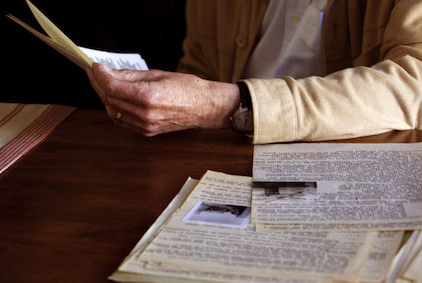 |
Ahlam Shibli, untitled (Trauma no. 29), Corrèze, France, 2008–09, chromogenic print, 38 x 57.7 cm. Tulle, 29th May, 2009. Pierre Diederichs, whose father was deported on the 10th June, 1944 and died at the Hersbruck concentration camp, looking at a report he wrote in 1960 about what he had seen in Algeria on a university study trip in July that year. At that time Pierre Diederichs represented the Union nationale des étudiants de France (UNEF), which in the 1960s took a clear position in favour of Algerian independence and initiated actions against the war. Courtesy of the artist, © Ahlam Shibli |
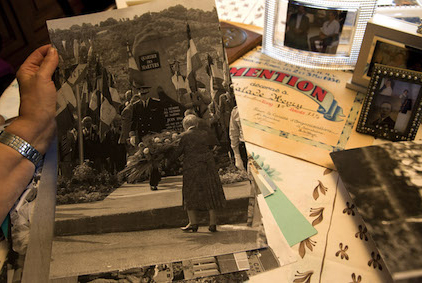 |
Ahlam Shibli, untitled (Trauma no. 30), Corrèze, France, 2008–09, chromogenic print, 38 x 57.7 cm. Tulle, 14th May, 2009. Janine Picard showing a photo of the wreath- laying ceremony at the Stèle des Martyrs, rue Louisa Paulin, close to the train station, on the 9th June, 1994, the 50th anniversary of the events, in memory of the citizens of Tulle who were hanged or deported in 1944. Displayed on the table are family photos of Janine Picard's parents, and an honorary diploma of her father, Henri-André Valade, who won the 1st prize in an accordion competition in 1936 in La Chaux-de-Fonds, Switzerland. Henri-André Valade was deported on the 10th June, 1944, to the detention camp Royallieu in Compiègne, and on the 2nd July to the Dachau concentration camp. He is considered to have died on the 16th January, 1945, at the Vaihingen camp. In Tulle he worked in the Maugein accordion factory as a tuner and was an accordionist in the company band. Janine conserved the virtuoso accordion, documents, and photos of her father. She is married to René Picard, a former French soldier in the Algerian War. Courtesy of the artist, © Ahlam Shibli |
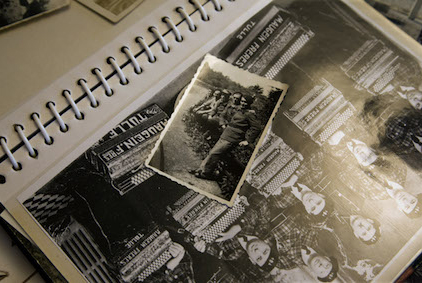 |
Ahlam Shibli, untitled (Trauma no. 31), Corrèze, France, 2008–09, chromogenic print, 38 x 57.7 cm. Tulle, 14th May, 2009. The photo album of Janine Picard's parents opened to show a photo of her father, Henri-André Valade, with his accordion band at the Maugein factory. On top of it, a photo of her father as a prisoner-of-war in May 1940, in the East of France, four years before his deportation to a German concentration camp on the 10th June, 1944. Courtesy of the artist, © Ahlam Shibli |
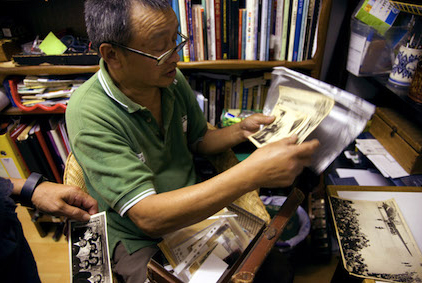 |
Ahlam Shibli, untitled (Trauma no. 32), Corrèze, France, 2008–09, chromogenic print, 38 x 57.7 cm. Argentat, 5th June, 2009. Thuong Dang – the son of a 'volunteer' from Indochina in the French Army during the First World War who remained in France after the war – showing his father's photos to Jeanette Kieu – the daughter of a forced labourer who was brought to France during the Second World War from Indochina. The photos depict the arrival of Ho Chi Minh in Paris in July, 1946 for the Fontainebleau Conference, and photos of Ho's reception by Indochinese workers in France, at the Le Bourget Airport, near Paris. The Fontainebleau Conference was held in July 1946 between the French Government and the Viet Minh to find a solution to the Franco-Vietnamese conflict. Ho Chi Minh led the Viet Minh delegation. Since the French were not willing to consider the Vietnamese claim for independence, a few months later the First Indochina War broke out. It ended in 1954 with the French defeat. Courtesy of the artist, © Ahlam Shibli |
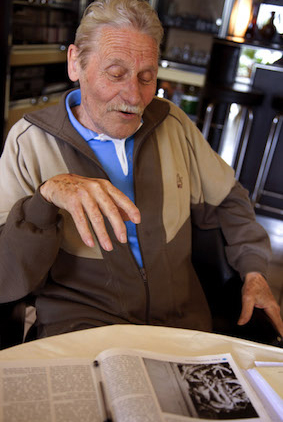 |
Ahlam Shibli, untitled (Trauma no. 33), Corrèze, France, 2008–09, chromogenic print, 38 x 57.7 cm. Naves, 11th June, 2009. Guy Piron served on a submarine in Indochina and North Africa and is the president of the Corrèze chapter of the Union française des anciens combattants et victimes de guerre (UFAC), which comprises veterans of the Second World War as well as those of the French colonial wars. He is looking at an issue of the magazine La Charte devoted to the memory of the war in Indochina. To the question what the image before his eyes represented, he answered, after a moment of silence: 'This is Tunisia.' Asked if he saw this in Tunisia, he reported that his army group arrived at a village, gathered all the inhabitants, marched them to a cement factory, and killed them. The image, however, illustrates a report on the German concentration camps, also featured in that issue of La Charte. Courtesy of the artist, © Ahlam Shibli |
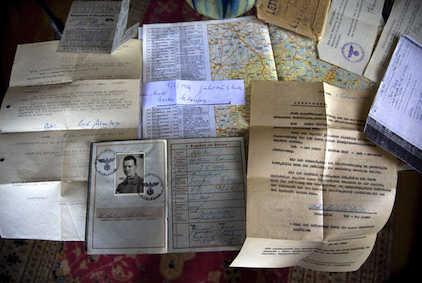 |
Ahlam Shibli, untitled (Trauma no. 34), Corrèze, France, 2008–09, chromogenic print, 38 x 57.7 cm. Chanac-les-Mines, 11th June, 2009. Daniel Espinat explained that the depicted documents were left behind by two German soldiers who fled when confronted by his Maquis group during the battle of Egletons, from the 14th to the 18th August, 1944. A service record mentions an injury of one of the soldiers: 'Splitter im Oberschenkel rechts' (splinter in the right thigh), and in the column 'theatre of war': 'Bandenbekämpfung in Frankreich' (fighting gangs in France). The use of the term gang shows how the German Army saw the French Résistance. Courtesy of the artist, © Ahlam Shibli |
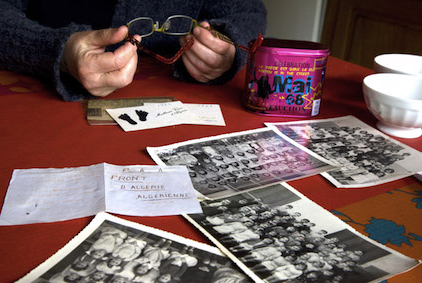 |
Ahlam Shibli, untitled (Trauma no. 35), Corrèze, France, 2008–09, chromogenic print, 38 x 57.7 cm. Saint-Jal, 8th June, 2009. Nadège Colladant, a French woman born in Oran, Algeria, in 1943, showing photographs of her primary school class and explaining that 'by the third year of primary school, the number of Algerian pupils had drastically decreased, and in the pictures we see that there are hardly any left'. She also shows a greeting card from 1962 with a drawing of black feet – pieds noirs – and underneath it another one from 1963, with the flag of independence, both inscribed 'Best wishes from Algeria'. These cards were bought shortly before and after the Algerian independence. Finally, there is a card that Nadège Colladant made herself during the war, featuring an invented association, FAA, Front d'Algérie algérienne, in opposition to a militant movement of Pieds-Noirs and Harkis in favour of French Algeria, the Front de l'Algérie française (FAF). Nadège Colladant said that her association had only two members, herself and her dog. Courtesy of the artist, © Ahlam Shibli |
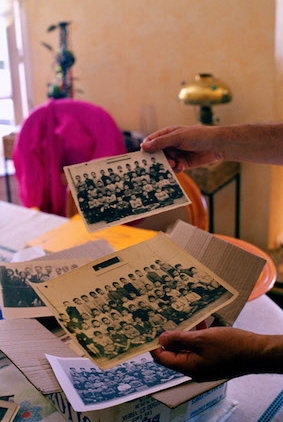 |
Ahlam Shibli, untitled (Trauma no. 36), Corrèze, France, 2008–09, chromogenic print, 38 x 57.7 cm. Tulle, 28th June, 2008. Christian Fuguet, a Pied-Noir born in 1948 in Algiers, showing photographs from his primary school. He explained that Algerian children from wealthy families attended the French primary school but were not allowed to be seated in the endof-the-year photo. Courtesy of the artist, © Ahlam Shibli |
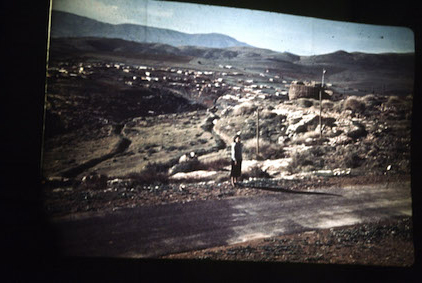 |
Ahlam Shibli, untitled (Trauma no. 37), Corrèze, France, 2008–09, chromogenic print, 38 x 57.7 cm. Tulle, 25th May, 2009. A slide projected by Concepción Le Guen which depicts her as a young woman in Algeria at a family outing, with an Algerian village in the background. Courtesy of the artist, © Ahlam Shibli |
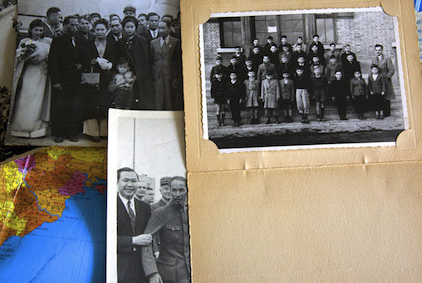 |
Ahlam Shibli, untitled (Trauma no. 38), Corrèze, France, 2008–09, chromogenic print, 38 x 57.7 cm. Argentat, 5th June, 2009. Pictures placed on top of the map of Vietnam, showing the arrival of Ho Chi Minh in Paris in July, 1946, for the Fontainebleau Conference between the French Government and the Viet Minh, and of his reception by Indochinese workers in France. From the collection of Thuong Dang, who is privately building an archive of documents concerning the French-Indochinese relations since the First World War. Courtesy of the artist, © Ahlam Shibli |
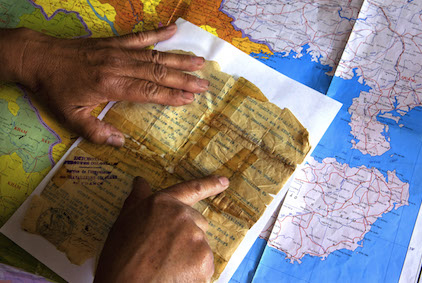 |
Ahlam Shibli, untitled (Trauma no. 39), Corrèze, France, 2008–09, chromogenic print, 38 x 57.7 cm. Argentat, 5th June, 2009. Thuong Dang presenting his father's first work contract in France, placed on top of the map of Vietnam. Courtesy of the artist, © Ahlam Shibli |
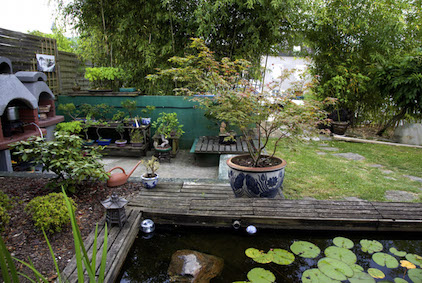 |
Ahlam Shibli, untitled (Trauma no. 40), Corrèze, France, 2008–09, chromogenic print, 38 x 57.7 cm. Argentat, 5th June, 2009. The Vietnamese house garden of Thuong Dang, the son of a 'volunteer' from Indochina who served in the French Army in the First World War and remained in France after the war. Courtesy of the artist, © Ahlam Shibli |
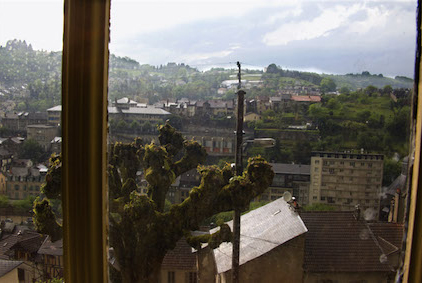 |
Ahlam Shibli, untitled (Trauma no. 41), Corrèze, France, 2008–09, chromogenic print, 38 x 57.7 cm. Tulle, 10th May, 2009. View of the Tulle city centre from the office window of the association Peuple et Culture Corrèze, in the upper part of the Alverge neighbourhood. The Ecole Turgot, located above the city centre, was built on the site of a prison used during the German occupation to incarcerate members of the Résistance. Courtesy of the artist, © Ahlam Shibli |
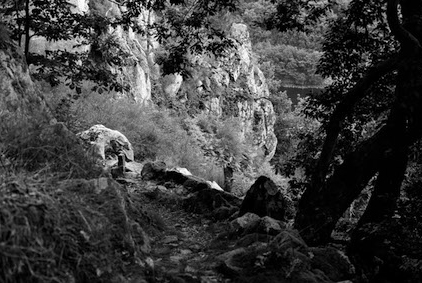 |
Ahlam Shibli, untitled (Trauma no. 42), Corrèze, France, 2008–09, gelatine silver print, 38 x 57.7 cm. Marcillac-la-Croisille, 12th June, 2008. Near the Roc de Busatier at Marcillac-la-Croisille, on the steep slopes of the Dordogne, a path leading to a cave which served as a hideout for one of the first armed Francs-tireurs et Partisans (FTP) groups and men who had escaped to the mountains to evade conscription into the the Service du travail obligatoire (STO) of Vichy France, which provided forced labour to the Germans. Georges Mandard (alias Jo la Rafale in the Maquis) was part of that first FTP camp and became second lieutenant FTP/FFI. After the Maquis he joined the 134th infantry regiment, called 'Oradour' because of the number of natives from the Limousin. After the regiment was dissolved in 1945, he joined the French Army again in 1946, just before the Fontainebleau Conference, responding favourably to the country's call to the Maquis volunteers to fight the Japanese. In fact he was mobilised in Indochina. He was killed on the 30th March, 1949 in Hoa Binh, blown up by a mine planted there by Viet Minh fighters. Courtesy of the artist, © Ahlam Shibli |
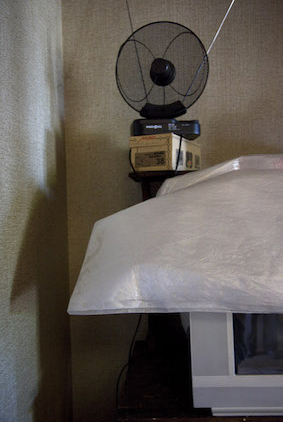 |
Ahlam Shibli, untitled (Trauma no. 43), Corrèze, France, 2008–09, chromogenic print, 38 x 57.7 cm. Saint-Bonnet-Elvert, 3rd June, 2009. Corner in a former bar where Résistance fighters used to rest their weapons. The owners' daughter, Amélie Boudrie, was an active member of the Résistance and married another member of the Résistance, Jean Boudrie. Courtesy of the artist, © Ahlam Shibli |
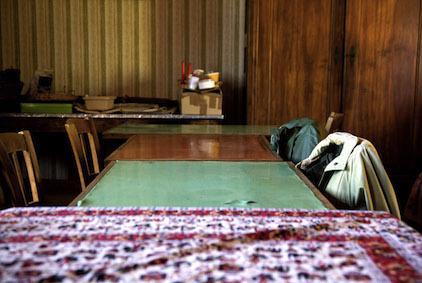 |
Ahlam Shibli, untitled (Trauma no. 44), Corrèze, France, 2008–09, chromogenic print, 38 x 57.7 cm. Saint-Bonnet-Elvert, 3rd June, 2009. Sitting area in a former bar that used to be visited by Résistance fighters. Courtesy of the artist, © Ahlam Shibli |
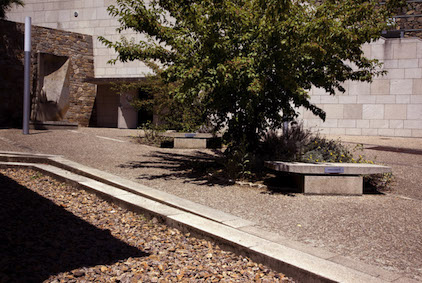 |
Ahlam Shibli, untitled (Trauma no. 45), Corrèze, France, 2008–09, chromogenic print, 38 x 57.7 cm. Tulle, 13th June, 2009. In the Parc du quai Baluze, a monument dedicated to Jean Moulin ('Max'), one of the most famous figures of the Résistance. As an emissary of General de Gaulle Jean Moulin succeeded in 1943 to unify several Résistance groups, and created the Conseil national de la Résistance (CNR). Courtesy of the artist, © Ahlam Shibli |
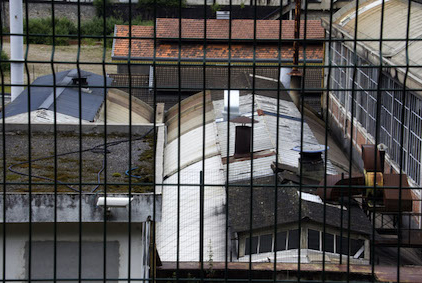 |
Ahlam Shibli, untitled (Trauma no. 46), Corrèze, France, 2008–09, chromogenic print, 38 x 57.7 cm. Tulle, 15th June, 2009. View of a building of the Manufacture d'armes de Tulle (MAT), a national weapons factory since the seventeenth century. During the German occupation the MAT fabricated parts for weapons to be used by the German army. Workers of the factory, 'legal' members of the Résistance, sometimes sabotaged the military material by changing the mechanisms. After the liberation, the MAT produced the MAT-49 submachine gun, which served widespread combat use during the First Indochina War, the Algerian War, and the 1956 Suez Crisis. The men who were rounded up by the SS on the 9th June, 1944, were held for unending hours at the MAT, and a large number of the victims of the 9th and 10th June, 1944, who were hanged or deported to German concentration camps, were MAT workers. Courtesy of the artist, © Ahlam Shibli |
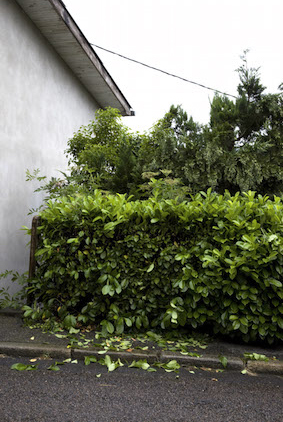 |
Ahlam Shibli, untitled (Trauma no. 47), Corrèze, France, 2008–09, chromogenic print, 38 x 57.7 cm. Tulle, 8th June, 2009. Hedge from which greeneries were cut by the Montagnac flower workshop to be used for the bouquets of the 7th, 8th, and 9th of June celebrations. Courtesy of the artist, © Ahlam Shibli |
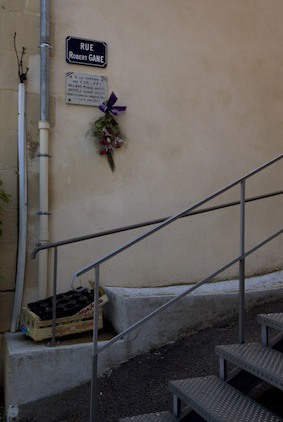 |
Ahlam Shibli, untitled (Trauma no. 48), Corrèze, France, 2008–09, chromogenic print, 38 x 57.7 cm. Tulle, 13th June, 2009. Bouquet of flowers to commemorate Marcel Delbos and André Bünzli, two members of the Francs tireurs et Partisans / Forces françaises de l'intérieur (FTP/FFI), killed by the Germans on the 7th June, 1944, during the Résistance attack in Tulle which ended with the arrival of the 2nd armoured SS division 'Das Reich' in the evening of the 8th June, 1944. André Bünzli was an electrical engineer at the Méchanique industrielle de precision (MIP) in Tulle, and involved in the Résistance movement against the German occupation. He took part in the attack on the garrison at the Hôtel Dufayet in the neighbourhood of the train station, although unarmed, since he refused to carry a gun out of principle. Before the Germans killed him he was able to hide sensitive documents he had been carrying with him. The body of André Bünzli was discovered in the ruelle Condamines, later renamed rue Robert Gane, after another member of the Résistance. It is not clear, however, if Bünzli actually found his death at that place. Marcel Delbos was a burnisher at the Manufacture d'armes de Tulle (MAT). It is not known with certainty where he actually fell. On the memorial plaque in rue Robert Gane, the name of Marcel Delbos is joined to André Bünzli's since both of them belonged to the 234th company of the FTP and found their death in the course of that company's retreat in the area of the train station in the late morning of the 7th June. Courtesy of the artist, © Ahlam Shibli |